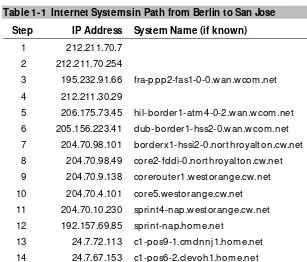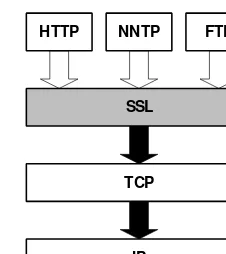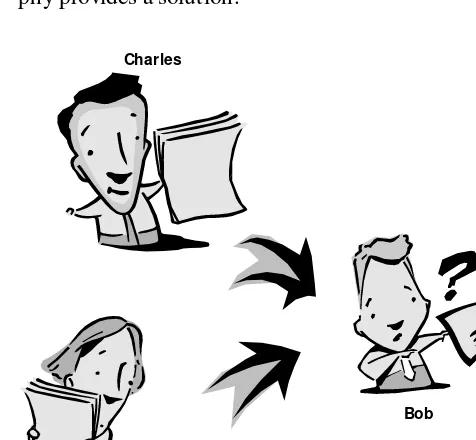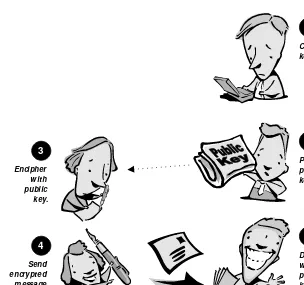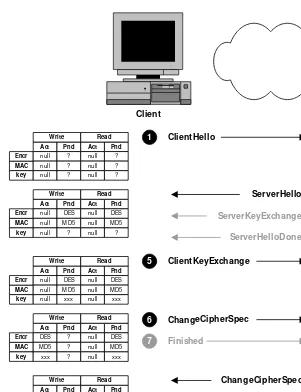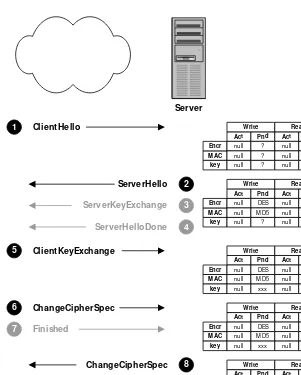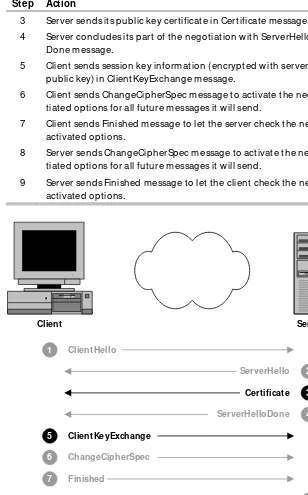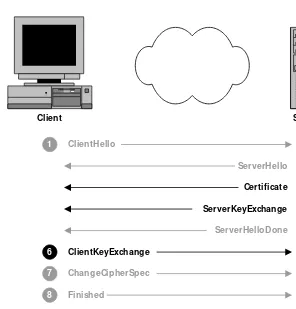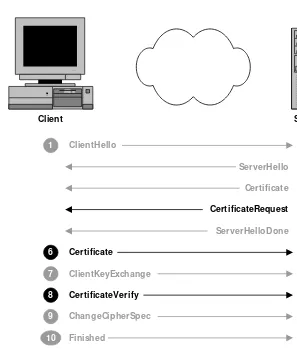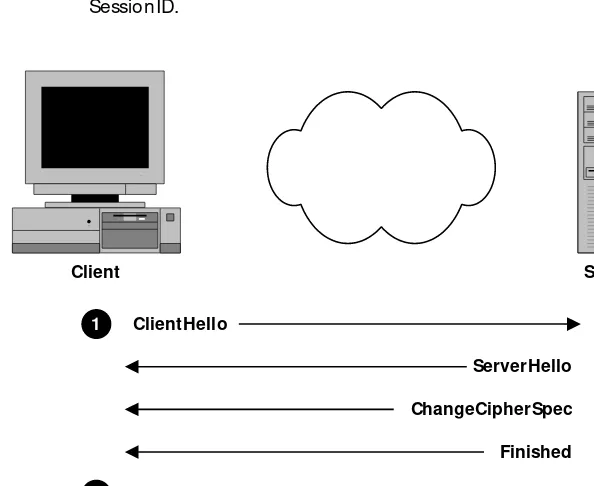SSL
and
TLS
Essentials
Securin g th e Web
Securing the Web
Stephen A. Thomas
Wiley Computer Publishing John Wiley & Sons, Inc.
Text D esign & Composition: Stephen T homas
D esignations used by companies to distinguish their products are often claimed as trademarks. In all instances where John W iley & Sons, Inc., is aware of a claim, the product names appear in initial capital or a l l ca pit a l l et t er s. Readers, however, should contact the appropriate companies for more complete information regarding trademarks and registration.
T his book is printed on acid-free paper.
Copyright © 2000 by Stephen A. T homas. All rights reserved.
Published by John W iley & Sons, Inc.
Published simultaneously in Canada.
No part of this publication may be reproduced, stored in a retrieval system or trans-mitted in any form or by any means, electronic, mechanical, photocopying, re-cording, scanning or otherwise, except as permitted under Section 107 or 108 of the 1976 United States Copyright Act, without either the prior written permission of the Publisher, or authorization through payment of the appropriate per-copy fee to the Copyright Clearance Center, 222 Rosewood D rive, D anvers, ma 01923, (978) 750-8400, fax (978) 750-4744. Requests to the Publisher for permission should be ad-dressed to the Permissions D epartment, John W iley & Sons, Inc., 605 T hird Avenue, New York, ny 10158-0012, (212) 850-6011, fax (212) 850-6008, email per m-r eq@wil ey.com.
T his publication is designed to provide accurate and authoritative information in re-gard to the subject matter covered. It is sold with the understanding that the pub-lisher is not engaged in professional services. If professional advice or other expert assistance is required, the services of a competent professional person should be sought.
Library of Congress Cataloging-in-Publication D ata: T homas, Stephen A., 1962-
ssl and t l s essentials : securing the Web / Stephen A. T homas. p. cm.
Includes index.
isbn 0-471-38354-6 (pbk./cd-rom : alk. paper)
1. Computer networks--Security measures. 2. World W ide Web--Security measures. 3. Computer network protocols. I. T itle.
t k5105.59 .t 49 2000
005.8--dc21 99-058910
Printed in the United States of America.
For Kelsie,
ix
Contents
Chapter 1: Introduction 1
1.1 Web Security and Electronic Commerce 2
1.2 H istory of SSL and T LS 4
1.3 Approaches to Network Security 6
1.3.1 Separate Security Protocol 8
1.3.2 Application-Specific Security 9
1.3.3 Security within Core Protocols 10
1.3.4 Parallel Security Protocol 11
1.4 Protocol Limitations 12
1.4.1 Fundamental Protocol Limitations 12
1.4.2 Tool Limitations 13
1.4.3 Environmental Limitations 14
1.5 O rganization of This Book 14
Chapter 2: Basic Cryptography 17
2.1 Using Cryptography 18
2.1.1 Keeping Secrets 18
2.1.2 Proving Identity 19
2.1.3 Verifying Information 20
2.2 Types of Cryptography 21
2.2.1 Secret Key Cryptography 22
2.2.2 Public Key Cryptography 24
2.2.3 Combining Secret & Public Key Cryptography 27
2.3 Key M anagement 29
2.3.1 Public Key Certificates 29
2.3.2 Certificate Authorities 31
2.3.3 Certificate H ierarchies 33
Chapter 3: SSL Operation 37
3.1 SSL Roles 37
3.2 SSL Messages 38
3.3 Establishing Encrypted Communications 39
3.3.1 ClientH ello 41
3.3.2 ServerH ello 43
3.3.3 ServerKeyExchange 45
3.3.4 ServerH elloDone 45
3.3.5 ClientKeyExchange 45
3.3.6 ChangeCipherSpec 46
3.3.7 Finished 51
3.4 Ending Secure Communications 52
3.5 Authenticating the Server’s Identity 52
3.5.1 Certificate 55
3.5.2 ClientKeyExchange 56
3.6 Separating Encryption from Authentication 56
3.6.1 Certificate 59
3.6.2 ServerKeyExchange 59
3.6.3 ClientKeyExchange 59
3.7 Authenticating the Client’s Identity 60
3.7.1 CertificateRequest 61
3.7.2 Certificate 62
3.7.3 CertificateVerify 63
3.8 Resuming a Previous Session 64
Chapter 4: Message Formats 67
4.1 Transport Requirements 68
4.2 Record Layer 69
4.3 ChangeCipherSpec Protocol 71
4.4 Alert Protocol 72
4.4.1 Severity Level 72
4.4.2 Alert Description 73
4.5 H andshake Protocol 74
4.5.1 H elloRequest 76
4.5.3 ServerH ello 79
4.5.4 Certificate 80
4.5.5 ServerKeyExchange 81
4.5.6 CertificateRequest 84
4.5.7 ServerH elloDone 85
4.5.8 ClientKeyExchange 85
4.5.9 CertificateVerify 88
4.5.10 Finished 90
4.6 Securing Messages 92
4.6.1 Message Authentication Code 93
4.6.2 Encryption 95
4.6.3 Creating Cryptographic Parameters 96
4.7 Cipher Suites 102
4.7.1 Key Exchange Algorithms 103
4.7.2 Encryption Algorithms 104
4.7.3 H ash Algorithms 104
Chapter 5: Advanced SSL 105
5.1 Compatibility with Previous Versions 105
5.1.1 Negotiating SSL Versions 106
5.1.2 SSL Version 2.0 ClientH ello 109 5.1.3 SSL Version 2.0 Cipher Suites 110
5.2 Netscape International Step-Up 111
5.2.1 Server Components 112
5.2.2 Client Components 112
5.2.3 Controlling Full-Strength Encryption 113 5.3 Microsoft Server G ated Cryptography 115 5.3.1 Server G ated Cryptography Certificates 115 5.3.2 Cipher Suite Renegotiation 115 5.4 The Transport Layer Security Protocol 117
5.4.1 TLS Protocol Version 118
5.4.2 Alert Protocol Message Types 118
5.4.3 Message Authentication 121
5.4.4 Key Material G eneration 123
5.4.5 CertificateVerify 125
5.4.7 Baseline Cipher Suites 126
5.4.8 Interoperability with SSL 128
5.5 The Future of SSL and T LS 128
Appendix A: X.509 Certificates 131
A.1 X.509 Certificate O verview 132
A.1.1 Version 132
A.1.2 Serial Number 133
A.1.3 Algorithm Identifier 133
A.1.4 Issuer 133
A.1.5 Period of Validity 133
A.1.6 Subject 134
A.1.7 Subject’s Public Key 134
A.1.8 Issuer Unique Identifier 134
A.1.9 Subject Unique Identifier 134
A.1.10 Extensions 135
A.1.11 Signature 135
A.2 Abstract Syntax Notation O ne 135
A.2.1 Primitive O bjects 136
A.2.2 Constructed O bjects 136
A.2.3 The O bject Identifier H ierarchy 137
A.2.4 Tagging 139
A.2.5 Encoding Rules 142
A.3 X.509 Certificate Definition 145
A.3.1 The Certificate O bject 145
A.3.2 The Version O bject 146
A.3.3 The CertificateSerialNumber O bject 147 A.3.4 The AlgorithmIdentifier O bject 147
A.3.5 The Validity O bject 148
A.3.6 The SubjectPublicKeyInfo O bject 148
A.3.7 The T ime O bject 149
A.3.8 The Extensions O bject 149
A.3.9 The UniqueIdentifier O bject 150
A.3.10 The Name O bject 150
Appendix B: SSL Security Checklist 161
B.1 Authentication Issues 161
B.1.1 Certificate Authority 162
B.1.2 Certificate Signature 163
B.1.3 Certificate Validity T imes 163 B.1.4 Certificate Revocation Status 163
B.1.5 Certificate Subject 163
B.1.6 Diffie-H ellman Trapdoors 164
B.1.7 Algorithm Rollback 164
B.1.8 D ropped ChangeCipherSpec Messages 165
B.2 Encryption Issues 166
B.2.1 Encryption Key Size 166
B.2.2 Traffic Analysis 167
B.2.3 The Bleichenbacher Attack 168
B.3 G eneral Issues 170
B.3.1 RSA Key Size 170
B.3.2 Version Rollback Attacks 171
B.3.3 Premature Closure 171
B.3.4 SessionID Values 172
B.3.5 Random Number G eneration 172
B.3.6 Random Number Seeding 173
References 175
Protocol Standards 175
Certificate Formats 176
Cryptographic Algorithms 177
SSL Implementations 178
Glossary 179
1
1
Introduction
Today alone, Dell Computer will sell more than $18 million worth of
computer equipment through the Internet. In 1999, nine million
Americans traded stocks online, accounting for one-third of all retail stock trades. And more than 200,000 Web sites worldwide (includ-ing sites belong(includ-ing to 98 of the Fortune 100) can accept e-commerce
transactions. Commercial use of the Web continues to grow at an as-tonishing pace, and securing Web transactions has become increas-ingly critical to businesses, organizations, and individual users.
Fortunately, an extremely effective and widely deployed communica-tions protocol provides exactly that security. It is the Secure Sockets Layer protocol, more commonly known simply as ssl . The ssl pro-tocol—along with its successor, the Transport Layer Security (t l s) protocol—is the subject of this book.
1.1 Web Security and Electronic Commerce
Know the enemy. Sun Tzu could not have offered any advice more ap-propriate to security professionals. Specific security services are nec-essarily effective against only specific threats; they may be completely inappropriate for other security threats. To understand SSL, therefore,
it is essential to understand the environment for which it has been designed.
Even though SSL is a flexible protocol that is finding use in many
dif-ferent applications, the original motivation for its development was the Internet. The protocol’s designers needed to secure electronic commerce and other Web transactions. That environment is certainly perilous enough. Consider, for example, what happens when a user in Berlin places an online order from a Web site in San Jose, California. Table 1-1 lists the systems through which the user’s messages might
pass.
Table 1-1 Internet Systems in Path from Berlin to San Jose
Step IP Address System Name (if known)
1 212.211.70.7
2 212.211.70.254
3 195.232.91.66 fra-ppp2-fas1-0-0.wan.wcom.net
4 212.211.30.29
5 206.175.73.45 hil-border1-atm4-0-2.wan.wcom.net
6 205.156.223.41 dub-border1-hss2-0.wan.wcom.net
7 204.70.98.101 borderx1-hssi2-0.northroyalton.cw.net
8 204.70.98.49 core2-fddi-0.northroyalton.cw.net
9 204.70.9.138 corerouter1.westorange.cw.net
10 204.70.4.101 core5.westorange.cw.net
11 204.70.10.230 sprint4-nap.westorange.cw.net
12 192.157.69.85 sprint-nap.home.net
13 24.7.72.113 c1-pos9-1.cmdnnj1.home.net
14 24.7.67.153 c1-pos6-2.clevoh1.home.net
15 24.7.64.173 c1-pos3-0.chcgil1.home.net
Step IP Address System Name (if known)
17 24.7.66.173 c1-pos8-3.lnmtco1.home.net
18 24.7.64.57 c1-pos1-0.slkcut1.home.net
19 24.7.66.77 c1-pos5-3.snjsca1.home.net
20 24.7.72.18 bb1-pos6-0-0.rdc1.sfba.home.net
21 172.16.6.194
22 10.252.84.3
23 10.252.10.150
24 209.219.157.152 www.sj-downtown.com
Figure 1-1 highlights the fact that messages containing the user’s
in-formation, including sensitive information such as credit card num-bers, may travel a complex path from G ermany to California, crossing through many countries, over various networks, and on many different facilities. Some of those facilities are likely to belong to private enterprises, many of which are not subject to any regula-tion or other laws governing the privacy of the informaregula-tion they transport.
Neither the user nor the Web server has any control over the path their messages take, nor can they control who examines the message contents along the route. From a security standpoint, it’s as if the user wrote her credit card number on a postcard and then delivered
Web Server Web Browser
the postcard as a message in a bottle. The user has no control over how the message reaches its destination, and anyone along the way can easily read its contents. Electronic commerce cannot thrive in such an insecure environment; sensitive information must be kept confidential as it traverses the Internet.
Eavesdropping isn’t the only security threat to Web users. It is theo-retically possible to divert Web messages to a counterfeit Web site. Such a counterfeit site could provide false information, collect data such as credit card numbers with impunity, or create other mischief.1
The Internet needs a way to assure users of a Web site’s true identity; likewise, many Web sites need to verify the identity of their users.
A final security challenge facing Web users is message integrity. A user placing an online stock trade certainly wouldn’t want his instructions garbled in such a way as to change “Sell when the price reaches $200” to “Sell when the price reaches $20.” The missing zero can make a significant difference in the user’s fortunes.
1.2 History of SSL and TLS
Fortunately, engineers were thinking about these security issues from the Web’s beginnings. Netscape Communications began considering Web security while developing its very first Web browser. To address the concerns of the previous section, Netscape designed the Secure Sockets Layer protocol.
Figure 1-2 shows the evolution of ssl in the context of general Web
development. The timeline begins in November 1993, with the release
of Mosaic 1.0 by the National Center for Supercomputing
Applica-tions (ncsa). Mosaic was the first popular Web browser. O nly eight months later, Netscape Communications completed the design for
_________________
1
SSL version 1.0; five months after that, Netscape shipped the first
product with support for SSL version 2.0—Netscape Navigator.
O ther milestones in the timeline include the publication of version
1.0 of the Private Communication Technology (P CT) specification.
Microsoft developed P CT as a minor enhancement to SSL version 2.0.
It addressed some of the weaknesses of SSL2.0, and many of its ideas
were later incorporated into SSL version 3.0.
The later events on the timeline represent a shift in focus for the SSL
standard. Netscape Communications developed the first three ver-sions of SSL with significant assistance from the Web community.
Al-though SSL’s development was open, and Netscape encouraged others
in the industry to participate, the protocol technically belonged to Netscape. (Indeed, Netscape has been granted a UuS. patent for SSL.)
Beginning in May 1996, however, SSL development became the
re-sponsibility of an international standards organization—the Internet Engineering Task Force (I E T F). The I E T F develops many of the
pro-tocol standards for the Internet, including, for example, T CP and I P. SSL 1.0
design complete
1993 1994 1995 1996 1997 1998 1999
SSL 2.0 product ships
PCT 1.0 published
SSL 3.0 published
TLS 1.0 published TLS WG
formed
NCSA Mosaic released
Netscape Navigator released
Internet Explorer released
SSL vs. TLS this one will note all those differ-ences.
To avoid the appearance of bias toward any particular company, the
I E T F renamed SSL to Transport Layer Security (T LS). The final version
of the first official T LS specification was released in January 1999.
Despite the change of names, T LS is nothing more than a new
ver-sion of SSL. In fact, there are far fewer differences between T LS 1.0
and SSL 3.0 than there are between SSL 3.0 and SSL 2.0. Section 5.4
details the differences between SSL and T LS, but check the sidebars
for more information.
Support for SSL is now built in to nearly all browsers and Web
serv-ers. For users of Netscape Navigator or Microsoft’s Internet Explorer,
SSL operates nearly transparently. O bservant users might notice the
“https:” prefix for an SSL-secured UR L, or they may see a small icon
that each browser displays when SSL is in use. (Figure 1-3 shows the
padlock symbol that Internet Explorer displays in the bottom status bar; Navigator shows a similar icon.) For the most part, however, SSL
simply works, safely providing confidentiality, authentication, and message integrity to its Web users.
Today’s popular Web servers also include support for SSL. It’s usually
a simple task to enable SSL in the server. As we’ll see, though, to
sup-port secure Web browsing, a Web server must do more than simply enable the SSL protocol. The server must also obtain a public key
cer-tificate from an organization that Web browsers trust. For users on the public Internet, those organizations are generally public certifi-cate authorities. Popular certificertifi-cate authorities include AT&T
Certifi-cate Services, GT E CyberTrust, KeyW itness International, Microsoft,
Thawte Consulting, and VeriSign. The next chapter includes further discussions of certificate authorities (primarily in section 2.3.2), and appendix A provides details on public key certificates.
1.3 Approaches to Network Security
support security services, though each has its own advantages and disadvantages. As we’ll see in this section, the designers of SSL chose
to create an entirely new protocol layer for security. It is also possible to include security services in the application protocol or to add them to a core networking protocol. As another alternative, applications can rely on parallel protocols for some security services. All of these options have been considered for securing Web transactions, and ac-tual protocols exist for each alternative. Table 1-2 summarizes the ad-vantages of each approach, and this section considers each of the possible approaches in more detail.
Table 1-2 Different Approaches to Network Security
Protocol Architecture Example A B C D E
Separate Protocol Layer SSL
Application Layer S-HTTP
Integrated with Core IPSEC
Parallel Protocol Kerberos
Benefits: A – Full Securit y B – Multiple Applications C – Tailored Services D – Transparent to Application E – Easy to Deploy
1.3.1 Separate Security Protocol
The designers of the Secure Sockets Layer decided to create a sepa-rate protocol just for security. In effect, they added a layer to the Internet’s protocol architecture. The left side of figure 1-4 shows the
key protocols for Web communications. At the bottom is the Inter-net Protocol (ip). This protocol is responsible for routing messages across networks from their source to their destination. The Transmis-sion Control Protocol (t cp) builds on the services of ip to ensure that the communication is reliable. At the top is the H ypertext Transfer Protocol; h t t p understands the details of the interaction between Web browsers and Web servers.
As the right side of the figure indicates, ssl adds security by acting as a separate security protocol, inserting itself between the h t t p appli-cation and t cp. By acting as a new protocol, ssl requires very few changes in the protocols above and below. The h t t p application in-terfaces with ssl nearly the same way it would with t cp in the ab-sence of security. And, as far as t cp is concerned, ssl is just another application using its services.
In addition to requiring minimal changes to existing implementa-tions, this approach has another significant benefit: It allows ssl to support applications other than h t t p. The main motivation behind the development of ssl was Web security, but, as figure 1-5 shows, ssl
HTTP
IP TCP HTTP
IP TCP SSL
Not Secure Secure
is also used to add security to other Internet applications, including those of the Net News Transfer Protocol (N N T P) and the File
Trans-fer Protocol (F T P).
1.3.2 Application-Specific Security
Although the designers of SSL chose a different strategy, it is also
possible to add security services directly in an application protocol. Indeed, standard H T T P does include some extremely rudimentary
se-curity features; however, those sese-curity features don’t provide ade-quate protection for real electronic commerce. At about the same time Netscape was designing SSL, another group of protocol
design-ers was working on an enhancement to H T T P known as Secure H T T P.
Figure 1-6 shows the resulting protocol architecture. The Secure
H T T P standard has been published by the I E T F as an experimental
HTTP
IP TCP SSL
NNTP FTP
Figure 1-5 SSL can add securit y to applications other than HTTP.
security
IP TCP HTTP
IP TCP
Not Secure Secure
HTTP
protocol, and a few products support it. It never caught on to the same degree as SSL, however, and oday it is rare to find Secure H T T P
anywhere on the Internet.
O ne of the disadvantages of adding security to a specific application is that the security services are available only to that particular appli-cation. Unlike SSL, for example, it is not possible to secure N N T P, F T P,
or other application protocols with Secure H T T P. Another
disadvan-tage of this approach is that it ties the security services tightly to the application. Every time the application protocol changes, the security implications must be carefully considered, and, frequently, the secu-rity functions of the protocol must be modified as well. A separate protocol like SSL isolates security services from the application
proto-col, allowing each to concentrate on solving its own problems most effectively.
1.3.3 Security within Core Protocols
The separate protocol approach of SSL can be taken one step further
if security services are added directly to a core networking protocol. That is exactly the approach of the I P security (I P SE C) architecture;
full security services become an optional part of the Internet Protocol itself. Figure 1-7 illustrates the I P SE C architecture.
The I P SE C architecture has many of the same advantages as SSL. It is
independent of the application protocol, so any application may use it. In most cases, the application does not need to change at all to
IP TCP HTTP
IP with IPSec TCP
Not Secure Secure
HTTP
take advantage of I P SE C. In fact, it may even be completely unaware
that I P SE C is involved at all. This feature does create its own
chal-lenges, however, as I P SE C must be sufficiently flexible to support all
applications. This complexity may be a big factor in the delays in de-velopment and deployment of I P SE C.
Another concern with the I P SE C approach is that it provides too
much isolation between the application and security services. At least in its simplest implementations, I P SE C tends to assume that secure
requirements are a function of a particular system, and that all appli-cations within that system need the same security services. The SSL
approach provides isolation between applications and security, but it allows some interaction between the two. The internal behavior of an application such as H T T P need not change when security is added,
but the application typically has to make the decision to use SSL or
not. Such interaction makes it easier for each application to direct the security services most appropriate to its needs.
Despite these drawbacks, I P SE C adds powerful new security tools to
the Internet, and it will undoubtedly see widespread deployment. The SSL protocol, however, has significant benefits as well, and its
deployment is also expected to grow substantially in the future.
1.3.4 Parallel Security Protocol
There is yet a fourth approach to adding security services to an appli-cation—a parallel security protocol. The most popular example of this strategy is the Kerberos protocol developed by the Massachusetts Institute of Technology. Researchers developed Kerberos to provide authentication and access control for resources in a distributed envi-ronment. The Kerberos protocol acts as a toolkit that other protocols can use for those security services. A remote login protocol such as Telnet, for example, can use Kerberos to securely identify its user.
In the very early days of Web browser development, some effort was made to incorporate Kerberos support within H T T P. Figure 1-8 shows
the resulting architecture. This work was never completed, though. Instead, there have been recent efforts to combine Kerberos with T LS.
mechanism for Transport Layer Security. Note, though, that Kerbe-ros alone is not a complete security solution. It does not have access to the actual information exchanged by the communicating parties. W ithout that access, Kerberos cannot provide encryption and de-cryption services.
1.4 Protocol Limitations
The SSL protocol, like any technology, has its limitations. And
be-cause SSL provides security services, it is especially important to
un-derstand its limits. After all, a false sense of security may be worse than no security. The limitations of SSL fall generally into three
cate-gories. First are fundamental constraints of the SSL protocol itself.
These are a consequence of the design of SSL and its intended
appli-cation. The SSL protocol also inherits some weaknesses from the tools
its uses, namely encryption and signature algorithms. If these algo-rithms have weaknesses, SSL generally cannot rehabilitate them.
Fi-nally, the environments in which SSL is deployed have their own
shortcomings and limitations, some of which SSL is helpless to
ad-dress.
1.4.1 Fundamental Protocol Limitations
Though its design includes considerations for many different applications, SSL is definitely focused on securing Web transactions.
Some of its characteristics reflect that concentration. For example,
IP TCP HTTP
IP TCP and UDP
Not Secure Secure
Kerberos HTTP
of its characteristics reflect that concentration. For example, SSL
re-quires a reliable transport protocol such as T CP. That is a completely
reasonable requirement in the world of Web transactions, because the H ypertext Transfer Protocol itself requires T CP. The decision means,
however, that SSL cannot operate using a connectionless transport
protocol like UD P.2 W ith this significant exception, Web transactions
are representative of general network computing environments. The
SSL protocol, therefore, can effectively accommodate most common
applications quite well. Indeed, SSL is in use today for securing
vari-ous applications, including file transfer, network news reading, and remote login.
Another role that SSL fails to fill is support for a particular security
service known as non-repudiation. Non-repudiation associates the digital equivalent of a signature with data, and when used properly, it prevents the party that creates and “signs” data from successfully de-nying that after the fact. The SSL protocol does not provide
non-repudiation services, so SSL alone would not be appropriate for an
application that required it.
1.4.2 Tool Limitations
The Secure Sockets Layer is simply a communication protocol, and any SSL implementation will rely on other components for many
functions, including the cryptographic algorithms. These algorithms are the mathematical tools that actually perform tasks such as en-cryption and deen-cryption. No SSL implementation can be any stronger
than the cryptographic tools on which it is based.
As of this writing, SSL itself has no known significant weaknesses.
Some common cryptographic algorithms, however, have been suc-cessfully attacked, at least in the context of academics or other re-search. (There are no publicly acknowledged cases of anyone
_________________
2
Although neither SSL nor T LS can use UD P, the W ireless Application Forum, an
in-dustry group developing standards for Internet access protocols for wireless devices such as mobile phones, has created a variation of T LS known as W ireless T LS (W T LS),
exploiting these theoretical weaknesses in a commercial context.) Appendix B describes the publicly reported attacks in more detail,
but, in general, SSL implementations must consider not only the
secu-rity of SSL, but also that of the cryptographic services on which it is
built.
1.4.3 Environmental Limitations
A network protocol alone can only provide security for information as it transits a network. No network protocol protects data before it is sent or after it arrives at its destination. This is the only known weakness in Web security that has been successfully exploited in an actual commercial setting. Unfortunately, it has been exploited more than once.3
Security in any computer network, whether the public Internet or private facilities, is a function of all the elements that make up that network. It depends on the network security protocols, the computer systems that use those protocols, and the human beings who use those computers. No network security protocol can protect against the confidential printout carelessly left on a cafeteria table.
The Secure Sockets Layer protocol is a strong and effective security tool, but it is only a single tool. True security requires many such tools, and a comprehensive plan to employ them.
1.5 Organization of This Book
Four more chapters and two appendices make up the rest of this book. Chapter 2 looks at some of the essential principles of cryptog-raphy and cryptographic algorithms. Although, strictly speaking, these algorithms are not part of the SSL protocol, a good bit of the
protocol’s design depends on general cryptographic principles. W ith-out getting too deep into the mathematics of cryptography, chapter 2
_________________
3
examines those essential principles. Chapter 3 begins the examination of ssl in earnest. It describes the ssl protocol in operation. It dis-cusses the contents of ssl messages, but only in general terms. The chapter explains what ssl does without getting bogged down in the details of how it does it. Chapter 4, on the other hand, focuses exclu-sively on those details. It documents the format of all ssl messages, as well as the cryptographic calculations ssl uses to construct them. Chapter 5 provides additional details about ssl . It describes how the current version of ssl operates with previous ssl versions, and how Netscape and Microsoft have each augmented ssl with techniques that promote strong encryption worldwide, while adhering to United States export restrictions. This chapter also provides complete cover-age of Transport Layer Security, detailing all the differences between t l s and ssl .
17
2
Basic
Cryptography
The Web may be a relatively new way to communicate, but securing the Web relies on the same principles that have secured other com-munications media for thousands of years. In fact, the digital nature of the Web actually makes it easier to apply these techniques. In ad-dition, systems on the Web can take advantage of new and powerful security technology. This chapter takes a brief look at the important principles that govern communications security.
The scientific discipline that studies communications security is cryp-tography, and several concepts from modern cryptography are indis-pensable to the Secure Sockets Layer protocol. The first of the following three sections describes the uses of cryptography. The next section looks in more detail at two particular types of cryptography— secret key cryptography and public key cryptography. As the names imply, keys are an important part of both types, and this chapter con-cludes by discussing the management of these keys. Key manage-ment plays a critical role in the operation of SSL.
As the following text implies, cryptography relies heavily on a mathematical foundation. But understanding the mathematics of cryptography is not essential for understanding SSL. For that reason,
2.1 Using Cryptography
The word cryptography is derived from the G reek for “secret writ-ing.” The task of keeping information secret is probably the one most often associated with cryptography. Indeed, protecting secret infor-mation is an important mission for cryptographers, but, as this sec-tion shows, cryptography has other uses as well. Two that are particularly important to SSL are proving identity and verifying
information. Table 2-1 summarizes the main topics of this section.
Table 2-1 Important Uses of Cryptography
Use Service Protects Against
Keeping secrets Confidentialit y Eavesdropping
Proving identit y Authentication Forgery and masquerade
Verifying information Message integrit y Alteration
2.1.1 Keeping Secrets
To continue with a convention that has become almost universal in cryptography texts, consider the dilemma facing Alice and Bob in figure 2-1. Alice needs to send Bob some important information. The
Alice Bob
Charles
information is extremely confidential, and it is important that no one other than Bob receive it. If, as in this example, the only way that Al-ice can communicate with Bob is by postcard, how can she send him the information without exposing it to mail carriers, snooping neighbors, or anyone else that happens to see the vital postcard?
Cryptography gives Alice and Bob the means to protect their ex-change. Before sending the postcard, Alice uses a secret code, or ci-pher, that only she and Bob understand. The cipher scrambles the information, rendering it unintelligible to parties such as Charles that do not know the secret code. Bob, however, knows the secret code and can decipher the necessary information.
2.1.2 Proving Identity
Now consider the situation in figure 2-2. Bob receives a postcard with important information, purportedly from Alice. But how does he know that the postcard really came from Alice? Might Charles have forged the card to make it appear as if from Alice? Again, cryptogra-phy provides a solution.
Alice Charles
Bob
Through the use of cryptography, Alice can attach special informa-tion, such as a secret phrase, to the postcard. This secret phrase is in-formation that only she and Bob know. Since Charles does not know the secret phrase, he will not be able to attach it to any forgery. Now all Bob has to do is look for the secret phrase. If it is present, then the postcard is genuine; if it is absent, he should be suspicious.
2.1.3 Verifying Information
Proving identity is one thing, but suppose Charles is able to intercept a genuine message to Bob from Alice. Charles could then modify the message and forward the altered message on to Bob, as in figure 2-3. Charles’s changes might alter the meaning of the message signifi-cantly, yet not destroy the secret phrase that “proves” Alice was the sender. To protect against this kind of behavior, there must be a way to not only verify the identity of the message source, but also to en-sure that the message contents have not been altered in any way. Again, cryptography offers a solution.
To validate the information on her postcard, Alice can use a special type of cryptographic function known as a hash function. A hash function creates a special mathematical summary of information. If the information is modified and the hash function recalculated, a dif-ferent summary will result. To prevent Charles from successfully tampering with her postcard, Alice calculates the hash function for the information on the card, plus a secret value only she and Bob
Alice Bob
Charles
know. She then adds the resulting summary to the postcard. W hen Bob receives the card, he can also calculate the hash function. If his summary matches that on the card, the information is valid.
Cryptographic hash functions resemble checksums or cyclic redun-dancy check (CRC) codes that are common error detection
mecha-nisms for traditional communication protocols. There is an important difference, though. Checksums and CRC codes are
de-signed to detect accidental alterations, such as might occur on an un-reliable transmission medium. Cryptographic hashes, on the other hand, are optimized to detect deliberate alterations. Because they as-sume the malicious attacker has full knowledge of the algorithm, and can thus exploit any weakness, effective hash functions are considera-bly harder to devise than standard error detection algorithms.
Two particular hash functions are essential to SSL implementations.
The first is Message Digest 5 (M Dm), devised by Ron Rivest. The
other important hash function is the Secure H ash Algorithm (SH A),
proposed by the U S. National Institute of Science and Technology.
Both will make their appearance in chapters 4 and 5 when we look at the details of the SSL and T LS specifications.
2.2 Types of Cryptography
As even the preceding brief introduction makes clear, one essential element of cryptography is the use of secret codes that are shared only by the communicating parties. W hether it’s keeping secrets, proving identity, or verifying information, Alice and Bob must know some secret information that Charles does not. Cryptographers call that information a key.
2.2.1 Secret Key Cryptography
W ith secret key cryptography, both parties know the same informa-tion—the key—and both endeavor to keep that key secret from eve-ryone else. This is how most people think of cryptography in general, and, for nearly all of the several-thousand-year history of secret codes, it was the only form of cryptography known. The critical as-pect of secret key cryptography is that both parties know the same secret information. For this reason, it has the technical name symmet-ric encryption.
Encryption algorithms, or ciphers, based on secret key techniques are usually just mathematical transformations on the data to be en-crypted, combined with the secret key itself. The approach resembles a carnival shell game, with the secret key serving as the initial loca-tion of the pea. Bits are swapped around and combined with each other in very complicated ways, and yet the various transformations can readily be undone, provided one knows the key. As a hint of the complexities involved, Figure 2-4 illustrates one of the more common encryption algorithms. The figure also introduces two common cryp-tographic terms—plaintext, information before encryption, and ci-phertext, information in its encrypted form. Plaintext is vulnerable to attackers; ciphertext, at least in theory, is not.
An important quality that determines the effectiveness of a cipher is the size of the secret key. The larger the key, the more difficult it is to break the code. To understand why this is the case, consider an algo-rithm with an extremely small key size: 2 bits. In this example, the algorithm itself really wouldn’t matter. After all, with 2 bits there are only four possible keys. An attacker who obtained encrypted data could simply try all four possibilities.
Cryptographers also characterize symmetric encryption algorithms according to how they process input data. Ciphers may be either
(and, thus, are by far the more common type). They are, however, slightly less convenient to use. The input data itself is the source of the inconvenience; it is rarely the same size as the cipher’s block. En-crypting data using a block cipher requires breaking the data into blocks, and, if the last block doesn’t contain exactly the right amount of data, adding dummy data, known as padding, to fill it out.
Block ciphers also usually require an initialization vector of dummy data to begin the encryption process. The initialization vector primes
plaintext
initial permutation
L0 R0
+ f
L1 = R0 R1 = L0 + f(R0,K1)
K1
+ f
L2 = R1 R2 = L1 + f(R1,K2)
K2
+ f
L15 = R14 R15 = L14 + f(R14,K15)
K15
[repeated 12 more times]
+ f
L15 = R15
R16 = L15 + f(R15,K16)
K16
inverse permutation
ciphertext
Secret Key
Data to Protect
Hidden Data
the algorithm with irrelevant information, enabling the cipher to build up to full strength before the actual plaintext appears.
Table 2-2 lists the symmetric ciphers most commonly used with the Secure Sockets Layer protocol.
Table 2-2 Symmetric Encryption Algorithms
Abbreviation Algorithm Type
DES Data Encryption Standard Block
3DES Triple-Strength Data Encryption Standard Block
RC2 Rivest Cipher 2 Block
RC4 Rivest Cipher 4 Stream
2.2.2 Public Key Cryptography
Most of the difficulties with traditional secret key cryptography are caused by the keys themselves. Both Alice and Bob need to have the same secret key, but under no circumstances should Charles have this key as well. That implies that before Alice and Bob can communicate information securely, they must be able to communicate the secret key securely. The problem mimics the classic chicken-or-egg di-lemma. After all, if there’s a secure way for Alice and Bob to com-municate the secret key, why can’t they use that same method to communicate the information, and dispense with the complexities of cryptography altogether? (In some situations, such as cloak-and-dagger spying, the two parties can agree on the key beforehand, while they’re physically together; for obvious reasons, this approach isn’t practical for situations in which the parties never meet face-to-face, such as Web-based commerce.)
Although it seems a bit like magic, this has a solid mathematical ba-sis. Fundamentally, asymmetric encryption is based on mathematical problems that are mush easier to generate than they are to solve. As an example, anyone with a pocket calculator can compute the prod-uct of 113 and 293 and get the correct answer of 33 109. It is much
more difficult, however, to use the same pocket calculator to work a similar problem in reverse. W hich two whole numbers, when multi-plied together, yield the product 29 213?1
Figure 2-5 shows how public key encryption can work. W hen Bob wants Alice to send him information securely, he generates two keys.
_________________
1
The answer, for the insatiably curious, is 131 and 223.
Alice Bob
1
2 3
4 5
Create keys.
Publish public key.
Decipher with private key. Encipher
with public key.
Send encrypted message.
O ne is the private key, which Bob keeps completely to himself. Con-versely, Bob advertises the public key, conceptually even by publishing it in a newspaper. Alice reads the newspaper to find out the public key, then uses it to encrypt the information. W hen Bob receives Al-ice’s postcard, his private key enables him to decipher the message. Since only Bob has his private key, only Bob can successfully decrypt the information. Even Alice would be unable to do so.
Some public key encryption algorithms, notably the Rivest Shamir Adleman (RSA) algorithm commonly used with SSL, also work in
re-verse. Information encrypted with a private key can be decrypted with the corresponding public key. This feature has several powerful applications, most importantly for SSLs as a way to prove identity.
Imagine, as in figure 2-6, that Bob encrypts some well-known
infor-mation using his private key and sends the resulting ciphertext to Al-ice. Alice can use Bob’s public key to decipher the information. She then compares the result with the well-known information she was expecting. If there is a match, then Alice is assured that the informa-tion was encrypted with Bob’s private key. O nly that key would have yielded the successful decryption. And, since Bob is the only person who knows his private key, Alice is further assured that Bob was the
Alice Bob
3
1
Encipher with private key.
Decipher with public key.
2
Publish public key.
one who sent the information. Through this approach, Bob has proven his identity to Alice.
Reversible public key algorithms such as RSA can also provide
an-other important service: the digital equivalent of a signature. Suppose that Bob needs information from Alice. And further suppose that it is important that Alice not be able to later deny sending him the in-formation, either to Bob or to an independent third party (such as a judge). In effect, Bob needs Alice to sign the information. To accom-plish this, Alice can encrypt the information with her private key. Since anyone can obtain her public key, anyone can decipher the in-formation. O nly Alice, however, knows her private key, so only Alice could have encrypted the information in the first place.
Some public key algorithms can only be used for digital signatures; they cannot provide encryption services. O ne such algorithm impor-tant to SSL is the Digital Signature Algorithm (D SA).
2.2.3 Combining Secret and Public Key Cryptography
Public key encryption is a powerful tool, but in most practical im-plementations it suffers from one serious disadvantage—the encryp-tion operaencryp-tion is extremely complex. Complex mathematical operations can place a strain on some systems, requiring more proc-essing capacity than the systems would otherwise need. If there were no alternatives, then most implementations requiring security might accept the higher system cost; fortunately, there is a relatively simple way to get the benefits of public key encryption while avoiding most of the system performance costs. The optimum approach uses a combination of secret key and public key cryptography.
Figure 2-7 shows how this combination can work in practice. To
O nce Alice and Bob have successfully exchanged the random num-bers, they no longer need public key encryption. Instead, they can use the random numbers as secret keys for standard symmetric encryp-tion. Alice and Bob can communicate securely as long as they wish. And since symmetric encryption does not need nearly as much pro-cessing power as asymmetric encryption, the encryption comes at a much lower cost.
There is an important variation to this process that relies on a differ-ent type of public key algorithm. The special type of algorithm is known as a key exchange algorithm, and the most famous example is the Diffie-H ellman algorithm. Diffie-H ellman is usually thought of as a public key algorithm, even though it cannot be used for
encryp-Alice Bob
tion or for digital signatures. Rather, Diffie-H ellman allows two par-ties to securely establish a secret number using only public messages. Diffie-H ellman is an alternative to steps 1–4 of figure 2-7.
O ne final note on figure 2-7: As the next chapter details, this is actu-ally a simplified view of basic ssl operation. Figure 3-1 shows a
dif-ferent version of the same process.
2.3 Key Management
Key management is a challenge to all forms of cryptography. Public key cryptography improves the situation; at least the keys that the parties exchange do not have to be kept secret from the rest of the world. Still, the public key must be exchanged reliably.
In the previous examples, Alice has hypothetically retrieved Bob’s public keys from the newspaper. Suppose, however, that the nefarious Charles was able to print a phony newspaper (with a phony public key for Bob) and sneak it into Alice’s driveway in the morning in place of her real paper. H ow would Alice know of the fraud?
It is exactly this problem that has led to the creation of public key certificates and certificate authorities. Although unnoticed by most casual Internet users, these are critical to the Secure Sockets Layer protocol and Web commerce.
2.3.1 Public Key Certificates
Figure 2-8 shows the contents of a typical public key certificate. Ap-pendix a discusses this particular certificate format in detail, but only a few of the fields are truly important. The first of those is the issuer
field, which identifies the organization that has issued the certificate. This information is critical to a person or computer system that ex-amines a certificate because it determines whether the certificate can be trusted. The next important field is the period of validity. Like driver’s licenses, certificates expire after a certain time. The next field identifies the subject of the certificate, and it is followed by the sub-ject’s public key.
The final field of the certificate is also important. That field is the is-suer’s signature, which is a digital signature of the contents of the cer-tificate. The issuer creates this signature by encrypting a hash of the certificate with its private key. Any system that knows the issuer’s public key can verify the signature and ensure the validity of the cer-tificate. Since this field can be a bit confusing, it is worthwhile to emphasize that the issuer creates the signature using its own private key, while the certificate itself contains the subject’s public key.
Version Serial Number Algorithm Identifier
Issuer Period of Validity
Subject Subject's Public Key
Issuer Unique ID Subject Unique ID
Extensions Signature
2.3.2 Certificate Authorities
The issuer of a public key certificate is traditionally known as a cer-tificate authority (CA), and certificate authorities play a vital role in
es-tablishing trust among a community of users. As the previous subsection indicates, the certificate authority digitally signs all cer-tificates, attesting to the validity of the public keys they contain. If users trust the certificate authority, they can trust any certificate that
CA issues.
In many cases, a certificate authority can be identified as either a pri-vate or a public CA. Private authorities include organizations that
is-sue certificates strictly for their own users. A corporation, for example, may issue public key certificates for its employees. (Actually, they would issue the certificates for the employees’ computers.) The company could then set up its internal network to require appro-priate certificates before granting access to critical data. Although systems within the company’s computer network could trust the company’s certificates, outside systems, including, for example, public Web servers, would be unlikely to do so. A private certificate author-ity issues certificates for use on its own private networks.
But the Internet is a public network, and Web security generally re-lies on public certificate authorities. A public certificate authority is-sues certificates to the general public, and it can certify the identity of both individuals and organizations. Public authorities act as the digital equivalent of notary publics, certifying the identity of any party that presents appropriate credentials. For a company that wishes to establish a secure Web site, those credentials may include a D un & Bradstreet DdUdNdS number, a business license, articles of
in-corporation, or SE C filings that establish the company’s corporate
identity.
Certificate authorities are themselves frequently identified by their certificates, but their certificates differ from standard certificates in one important respect: the subject and the issuer are one and the same. The certificate authority certifies its own identity. Figure 2-9
highlights the fact that the public key in a CA certificate is also the
distinction from normal certificates. Any party that receives a normal certificate can check the certificate’s signature to decide whether to trust the public key in that certificate. As long as the certificate’s sig-nature is valid and the issuer is trustworthy, then the receiving party can safely trust the public key. W ith a CA certificate, on the other
hand, verifying the certificate’s signature does not help to establish trust. Any party that could forge a CA certificate would know the
forged private key, and could thus easily generate the matching cer-tificate signature. The validity of CA certificates must be established
by other methods.
In the case of Web commerce security, the validity of certificate au-thorities depends largely on the browser manufacturers. Both Micro-soft’s Internet Explorer and Netscape’s Navigator by default recognize the certificates from important public certificate authori-ties. Figure 2-10 shows some of the certificate authorities Netscape
recognizes. (The full list, as of this writing, includes more than 50 au-thorities.) Although both Netscape and Microsoft allow users to in-stall additional certificate authorities into their browsers, most secure Web sites elect to use a certificate that doesn’t require this extra ef-fort from their users.
Version Serial Number Algorithm Identifier
Issuer Period of Validity
Subject Subject's Public Key
Issuer Unique ID Subject Unique ID
Extensions Signature
Issuer and Subject are the same.
Subject's Public Key verifies the certificate's Signature.
2.3.3 Certificate Hierarchies
Sometimes, it becomes difficult for a certificate authority to effec-tively track all the parties whose identities it certifies. Especially as the number of certificates grows, a single authority may become an unacceptable bottleneck in the certification process. Fortunately, public key certificates support the concept of certificate hierarchies, which alleviate the scalability problems of a single, monolithic au-thority.
W ith a hierarchy in place, a certificate authority does not have to certify all identities itself. Instead, it designates one or more subsidi-ary authorities. These authorities may, in turn, designate their own subsidiaries, the hierarchy continuing until an authority actually cer-tifies end users. Figure 2-11 illustrates a simple three-level hierarchy,
one that might occur within a large corporation. As the figure shows, the acme Corporation has a master certificate authority and two subordinate authorities, one for H uman Resources and another for Research and Development. The subordinate authorities are respon-sible for entities within their domains.
A particularly powerful feature of certificate hierarchies is that they do not require that all parties automatically trust all the certificate authorities. Indeed, the only authority whose trust must be estab-lished throughout the enterprise is the master certificate authority. Because of its position in the hierarchy, this authority is generally known as the root authority.
To see this process in action, consider what happens when a client in the RrD department needs to verify the identity of the Benefits
server. The server presents its certificate, issued (and signed) by the
H R department’s authority. The RrD client does not trust the H R
au-thority, however, so it asks to see that authority’s certificate. W hen the client receives the H R authority’s certificate, it can verify that the H R authority was certified by the corporation’s root CA. Since the RrD client does trust the root CA, it can trust the Benefits server.
2.3.4 Certificate Revocation Lists
Before leaving the subject of public key certificates, there is one loose end to tie up. So far, we’ve seen how certificate authorities issue cer-tificates, but what about the reverse process? W hat happens if a CA
issues a certificate by mistake and wants to correct itself? O r what if a subject accidentally reveals its private key, so its certified public key is no longer safe to use? To solve these types of problems, certificate au-thorities use certificate revocation lists. A certificate revocation list, or CR L for short, is a list of certificates that the authority has
previ-ously issued, but no longer considers valid. The certificates them-selves still appear legitimate; their signatures are correct, and their validity periods are appropriate. Nonetheless, the CA needs to
indi-cate that they can no longer be trusted. The authority cannot change the certificates since they’ve already been issued, so the best it can do is maintain a list of these revoked certificates. It is the responsibility of any party that trusts another’s certificate to check with the certifi-cate authority to make sure the certificertifi-cate has not been revoked. This function is not the responsibility of the SSL protocol, so we won’t
dis-cuss it in any depth. It is noteworthy to consider, though, that the current Web commerce infrastructure does not have an effective (and widely supported) means for systems to check a certificate against a
CR L. For that reason, there is no practical way to revoke a traditional
37
3
SSL
Operation
W ith an understanding of some of the key concepts of cryptography, we can now look closely at the operation of the Secure Sockets Layer (SSL) protocol. Although SSL is not an extremely complicated
proto-col, it does offer several options and variations. This chapter explains
SSL by starting with the simplest case: establishing an encrypted
communications channel. It then considers successively more com-plex options, including authenticating the communicating parties, separating encryption from authentication, and resuming a previously established session. W ithin these sections, you will discover the full power of SSL.
The SSL protocol consists of a set of messages and rules about when
to send (and not to send) each one. In this chapter, we consider what those messages are, the general information they contain, and how systems use the different messages in a communications session. We do not, however, explore the detailed message formats: the bits and bytes that make up SSL messages as they transit across a network.
That detail is the subject of chapter 4. Neither do we spend time here on the detailed cryptographic computations SSL requires; those, too,
are a topic for the next chapter. This chapter concentrates on the big picture. The details will be much easier to understand once you have an appreciation of the overall operation of the Secure Sockets Layer.
3.1 SSL Roles
is a server. The distinction is very important, because SSL requires the
two systems to behave very differently. The client is the system that initiates the secure communications; the server responds to the cli-ent’s request. In the most common use of SSL, secure Web browsing,
the Web browser is the SSL client and the Web site is the SSL server.
These same two roles apply to all applications that use SSL, and the
examples in this chapter (indeed, throughout the book) will clearly distinguish them.
For SSL itself, the most important distinctions between clients and
servers are their actions during the negotiation of security parame-ters. Since the client initiates a communication, it has the responsibility of proposing a set of SSL options to use for the
exchange. The server selects from the client’s proposed options, deciding what the two systems will actually use. Although the final decision rests with the server, the server can only choose from among those options that the client originally proposed.
3.2 SSL Messages
W hen SSL clients and servers communicate, they do so by
exchang-ing SSL messages. Technically, SSL defines different levels of messages,
but that topic is best left for Chapter 4. Since this chapter concen-trates strictly on functionality, distinguishing between the various SSL
levels is not critical. Table 3-1 lists the SSL messages at all levels of the
protocol, in alphabetical order. The remaining sections in this chapter show how systems use these messages in their communications.
Table 3-1 SSL Messages
Message Description
Alert Informs the other part y of a possible securit y
breach or communication failure.
ApplicationData Actual information that the two parties
ex-change, which is encrypted, authenticated, and/ or verified by SSL.
Certificate A message that carries the sender’s public key
Message Description
CertificateRequest A request by the server that the client provide its public key certificate.
CertificateVerify A message from the client that verifies that it knows the private key corresponding to its pub-lic key certificate.
ChangeCipherSpec An indication to begin using agreed-upon
secu-rit y services (such as encryption).
ClientHello A message from the client indicating the
secu-rit y services it desires and is capable of support-ing.
ClientKeyExchange A message from the client carrying
crypto-graphic keys for the communications.
Finished An indication that all initial negotiations are
complete and secure communications have been established.
HelloRequest A request by the server that the client start (or
restart) the SSL negotiation process.
ServerHello A message from the server indicating the
secu-rit y services that will be used for the communi-cations.
ServerHelloDone An indication from the server that it has
com-pleted all its requests of the client for establish-ing communications.
ServerKeyExchange A message from the server carrying
crypto-graphic keys for the communications.
3.3 Establishing Encrypted Communications
The most basic function that an SSL client and server can perform is
establishing a channel for encrypted communications. Figure 3-1
shows the SSL message exchange this operation requires, and table 3-2
Table 3-2 Negotiation of Encrypted Communications
Step Action
1 Client sends ClientHello message proposing SSL options.
2 Server responds with ServerHello message selecting the SSL options.
3 Server sends its public key information in ServerKeyExchange message.
4 Server concludes its part of the negotiation with ServerHello-Done message.
5 Client sends session key information (encrypted with server’s public key) in ClientKeyExchange message.
6 Client sends ChangeCipherSpec message to activate the
nego-tiated options for all future messages it will send.
Server
ClientHello
ServerHello
ServerKeyExchange
ServerHelloDone
ClientKeyExchange
ChangeCipherSpec
Finished
ChangeCipherSpec
Finished
1
2 3 4
5
6
7
8 9
Client
SSL vs. TLS
7 Client sends Finished message to let the server check the newly activated options.
8 Server sends ChangeCipherSpec message to activate the
nego-tiated options for all future messages it will send.
9 Server sends Finished message to let the client check the newly activated options.
3.3.1 ClientHello
The ClientHello message starts the SSL communication between the
two parties. The client uses this message to ask the server to begin negotiating security services by using SSL. Table 3-3 lists the impor-tant components of a ClientH ello message.
Table 3-3 ClientHello Components
Field Use
Version Identifies the highest version of the SSL
proto-col that the client can support.
RandomNumber A 32-byte random number used to seed the
cryptographic calculations.
SessionID Identifies a specific SSL session.
CipherSuites A list of cryptographic parameters that the
cli-ent can support.
CompressionMeth-ods
Identifies data compression methods that the client can support.
The Version field of the ClientH ello message contains the highest version number of SSL that the client can support. The current SSL
version is 3.0, and it is by far the most widely deployed on the Inter-net. (But see the sidebar for information on T LS.) Note that a server
may assume that the client can support all SSL versions up to and
in-cluding the value of this field. If, for example, a client sends a version
3.0 ClientH ello to a server that only supports version 2.0 of SSL, the
the communication attempt. Section 5.1 includes additional
informa-tion about compatibility with previous versions.
The R andomNumber field, as you might expect, contains a random number. This random value, along with a similar random value that the server creates, provides the seed for critical cryptographic calcula-tions. Chapter 4 has the details. The ssl specification suggests that four of this field’s 32 bytes consist of the time and date. The ssl pro-tocol does not require a particular level of accuracy for this value, as it is not intended to provide an accurate time indication. Instead, the specification suggests using the date and time as a way to ensure that the client never uses the same random value twice. This precaution protects against an impostor copying old ssl messages from a legiti-mate client and reusing them to establish a counterfeit session.
The remaining 28 bytes of this value should be a “cryptographically secure” random number. Security is not something we ordinarily as-sociate with randomness, but it is important in this case. Most com-puter programs use a technique known as pseudorandom number generation to create random numbers. W hen used correctly, this ap-proach does yield numbers that have the appearance of randomness. H owever, the technique does have a serious flaw when used in a se-curity context: if an attacker knows the exact algorithm and one ran-dom value, that attacker can correctly predict all future ranran-dom values. This knowledge might allow the attacker to anticipate a par-ticular future value and prepare an attack against it. To prevent this type of attack, ssl implementations should use a different technique for generating random numbers; typically, they use one based on cryptographic algorithms.
The next field in the ClientH ello message is SessionID. Although all ClientH ello messages may include this field, in this example, the field is meaningless and would be empty. Section 3.8 presents an ex-ample of how the SessionID field may be used.
